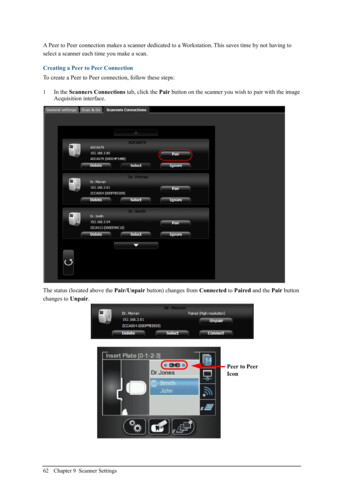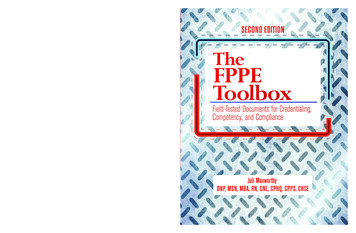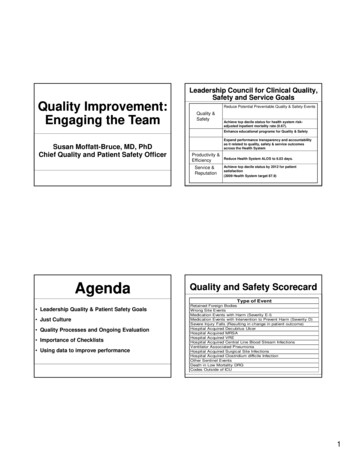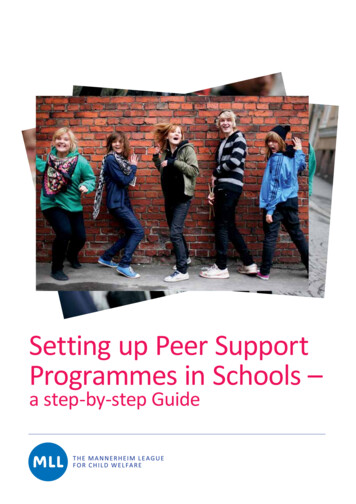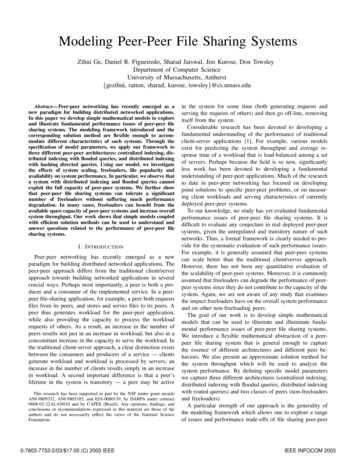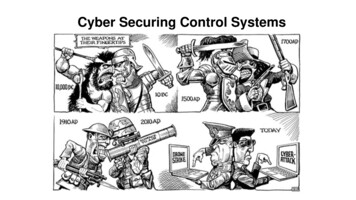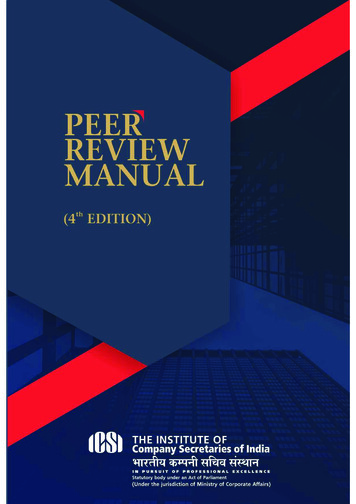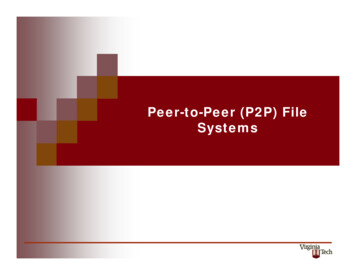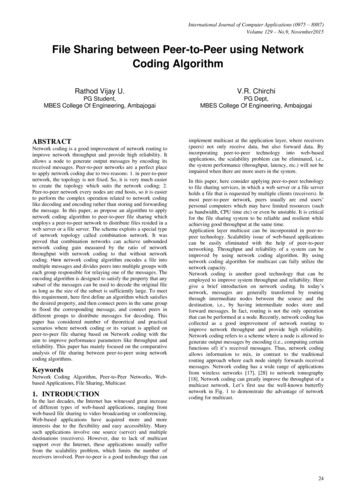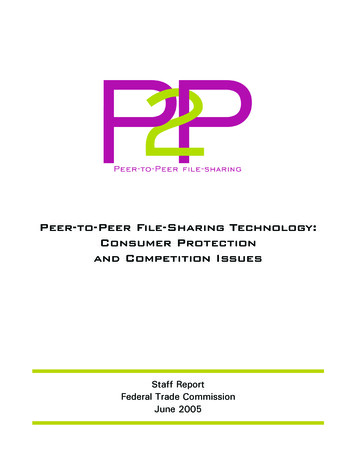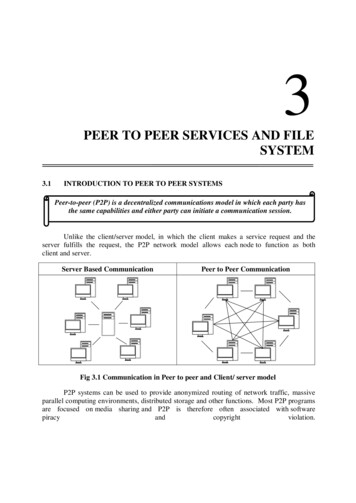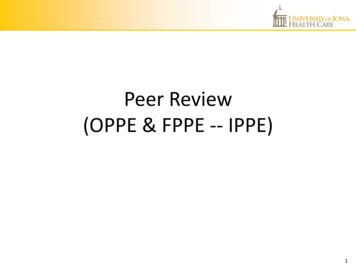
Transcription
Peer Review(OPPE & FPPE -- IPPE)1
Why do Peer Review? “Since the continuation of clinicians’ privileges at ahospital hinges on the quality and safety of caredelivered to patients, the review of privileges is acritical – and sensitive – process. Thisresponsibility falls on the medical staff(Credentialing committees), which monitors theperformance of all practitioners who are grantedprivileges and makes recommendations to thegoverning body of the hospital (Hospital AdvisoryCommittee) concerning which medical staffmembers should receive new or maintain existingprivileges. ”The Joint Commission, Aug 21, 20132
Results in OPPE/FPPE: OPPE/FPPE determines if the care provided by aprovider is at or below an acceptable level. Organizations that have been able to collectmeaningful data in an ongoing way, and providethat data to individual providers (particularly ifaccompanied by peer or benchmark data) havefound that practitioners become actively engagedboth in validating the data and in self-evaluationand modifications in practice.– This results in quality improvement.3
Definitions OPPE: Ongoing professional practiceevaluation FPPE: Focused professional practice evaluation– Initial/Increased FPPE: IPPE IPPE is a subset of TJC FPPE -- UIHC term Initial or Increased when a practitioner requests new orincreased privileges– Triggered FPPE Triggered by a concern or series of concerns aboutpractice or professionalism4
Peer ReviewStart DateEventPrivileged Provider TimelineOPPEInitial FPPEIncreased FPPETriggered FPPE5
IPPE – Initial or increased6
Peer ReviewStart DateEventPrivileged Provider TimelineOPPEInitial FPPEIncreased FPPETriggered FPPE7
OPPE - Ongoing Ongoing Professional Practice Evaluation (OPPE) is required ofall privileged medical staff in all departments and services. It isa mechanism to continually track medical staff with respect tothe core competencies necessary to maintain privileges.These competencies should include: 1) medical and clinicalknowledge, 2) patient care, 3) inter personal skills andcommunication, 4) practice based learning, 5) professionalismand 6) system based practice. A successful OPPE/FPPE program should include all of thesecomponents.8
9
10
11
OPPE Ratings (using latest quarter) REVIEW (any red)– At least one of the metrics is UNFAVORABLE– Requires action plan for improvement developed by faculty and ClinicalService Head (DEO)– Serious concerns, or lack of improvement over 2 cycles may result inTriggered FPPE MEETS MOST GOALS (no red, some yellow)– No metrics are unfavorable, however, one or more may needimprovement to reach the ideal goal GOALS MET (all green)– All metrics for which there is data are favorable to goal12
OPPE departmentresponse form19
Triggered FPPE –Frequently referred to as “Peer Review”Start DateEventPrivileged Provider TimelineOPPEInitial FPPEIncreased FPPETriggered FPPE20
Three Peer Review Committees Medical Committee Surgical Committee Professional/Behavioral Committee21
FPPE WORKFLOWEvaluation triggered by the Clinical Service Head/Department Executive Officer (DEO), Chief Executive Officer (CEO) or Chief of Staff(COS)UIHC PEERREVIEWWORKFLOWEvaluation is received in the Clinical Staff Office (CSO) and assigned to the appropriate Committee Chair by the Chief Medical Officer (CMO)Peer Review Committee Chair evaluates trigger to assure case meets criteria for reviewYESNODISAGREECommittee member evaluates, completes form, and assigns rankCMO repeatsEvaluationAGREERank 1:Referred for second evaluationSecondpanelistevaluatesand agreeswithranking of1No furtheraction; place inCSO fileRank 2 or 3 oruncertainSecond committee member disagrees with ranking of 1No furtheraction;place inCSO fileCase discussed at full Committee Meeting; ranking assignedCase ranked1Rank 2 or 3: LIP reviews rankingand responds (Letter to Peer Review Committee and DEO)No furtheraction; placein CSO fileCase discussed at full CommitteeMeeting; ranking assigned, with possible recommendationsCase ranked1No furtheraction; place inCSO fileCase Ranked2Case Ranked3Case ranked 2: Report sent toDEO, who drafts an educationaland performance improvementletter to LIP, copy of report andletter to CMO, OPPE oversight andplaced in CSO and department filesLIP AGREESEducation plan,including follow uptime line andconsequences ofnoncomplianceestablished with DEOLIP DISAGREESReferral may be madeto Corrective Actiondetailed under ArticleIV, Section 6. of theBylaws Rules andRegulations of theUIHC and Its ClinicalStaffCase ranked 3: Report sent toDEO and LIP, DEO reviews andmakes recommendations, takesaction and sends a copy of reportand letter to CMO, OPPEoversight and placed in CSO anddepartment filesLIP AGREESPerformanceImprovement plan,timeline andconsequences ofnoncompliance agreed onby Chair, LIP, CMO,Risk Management andAssistant Dean FacultyAffairs22
ContactTeri Brennantheresa-brennan@uiowa.eduOffice of the CMO: (319) 467-5700Pager: 4088I am available on VoalteMeHolly Kolfenbachholly-kolfenbach@uiowa.eduOffice: (319) 384-928923
delivered to patients, the review of privileges is a critical - and sensitive - process. This responsibility falls on the medical staff (Credentialing committees), which monitors the performance of all practitioners who are granted privileges and makes recommendations to the governing body of the hospital (Hospital Advisory
